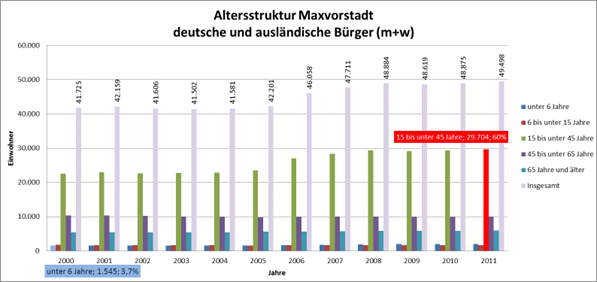Maxvorstadt
Historical Background
Munich’s third district was named Maxvorstadt between 1805 and 1810 after the first Bavarian King Maximilian I Joseph. After 1825, under Ludwig I, it became the first planned expansion of the city. Since the restructuring of the city district in 1992, this district has incorporated the former districts 5, 6, and 7 (Maxvorstadt-University, Maxvorstadt-Königsplatz-Marsfeld, and Maxvorstadt-Josephsplatz).
Location
Maxvorstadt borders the Old Town directly to the south between Odeonsplatz and Stachus and is bordered to the east by the English Garden. To the north, the districts of Schwabing 4 and 12 are adjacent.
Maxvorstadt today
Maxvorstadt, also known as Munich’s Museum Quarter, forms the center of classical Munich. The famous Siegestor marks the “solemn entrance” to Maxvorstadt. Among the architectural highlights are Odeonsplatz, Wittelsbacherplatz, Karolinenplatz, and Königsplatz. Art, culture, and science have shaped this district, both then and now. The area is home to a large number of cultural and artistic institutions, such as the Lenbachhaus with its Art House, the Alte and Neue Pinakothek, the University of Music and Performing Arts, the Museum of Sacred Art, and many more. In addition to the cultural and artistic institutions, the district also stands out for its exceptionally high number of educational institutions, including the Technical University, Ludwig Maximilian University, the University of Applied Sciences, the State and University Library, and many others. However, more and more expensive bars and fashion stores are replacing many of the long-established shops, thus changing the district’s formerly student-oriented character. Since the end of the 20th century, Maxvorstadt has also undergone structural change. Many areas once used exclusively for industry and commerce are now transforming into residential and working neighborhoods. One example of this is the former brewery site behind the Löwenbräukeller, where a total of 70,000 m² of gross floor area has been built.
Notable Buildings and Present-Day Development
The well-known Joseph’s Church at Josephsplatz is the second Catholic parish church and was built in the Neo-Baroque style. The Old Northern Cemetery is now often used as a park for picnics, as no burials have taken place there since 1939. However, the most significant buildings can be found at Königsplatz in the district. It is dominated by three characteristic buildings from the classical period: the Glyptothek, the Collection of Antiquities, and the Propyläen, a monumental gateway.
The current buildings in the district alternate between modern residential complexes and historic buildings from the Gründerzeit period. Many rental houses are being converted into stylish condominiums. In total, about 29.96 hectares of undeveloped land offer recreational and sports opportunities.
The age structure in Maxvorstadt.
Based on the development and analysis of statistics on the age structure in Maxvorstadt, the following trend can be summarized from 2000 to 2011. The bar chart below shows an increase in both German and foreign citizens (m/f) aged 15 to under 45 years, rising by up to 7,134 people. This represents a percentage increase of 5.9%. The largest increase of 3,560 people was recorded between 2005 and 2006. Today, up to 41,606 people live in this district.

Numbers and Facts
- Area: 427.68 hectares.
- Population: 50,877.
- Population density: 119 inhabitants per hectare.




